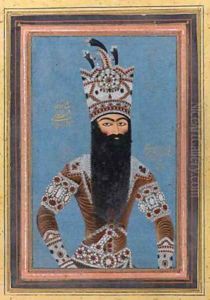Mihr'Ali Paintings
Mihr'Ali was a distinguished Iranian artist, renowned for his mastery in portrait painting, particularly during the Qajar era. While the exact dates of his birth and death remain uncertain, his artistic legacy situates him prominently in the late 18th to early 19th centuries. He served as a court painter under Fath-Ali Shah Qajar, the second Qajar king, who ruled from 1797 to 1834. Mihr'Ali's work is emblematic of the Qajar era's distinctive artistic style, characterized by elaborate detail, vibrant colors, and a particular emphasis on portraiture, which was a significant departure from the predominantly calligraphic and abstract art traditions of earlier Islamic periods.
His portraits, often grandiose and imbued with a sense of regality, not only served as depictions of courtly life but also as tools of political and social significance. Through his art, Mihr'Ali played a crucial role in crafting the image of Fath-Ali Shah and his dynasty, portraying the Shah in a manner that emphasized royal power, divine sanction, and the continuity of Persian monarchy. One of his most famous works is the portrait of Fath-Ali Shah, where the Shah is depicted with his characteristic long beard and elaborate crown, surrounded by symbols of power and sovereignty. This portrait, like many of his works, highlights Mihr'Ali's skill in capturing the opulence of the Qajar court and the intricacies of Persian attire and jewelry with meticulous attention to detail.
Mihr'Ali's contribution to Iranian art is significant, as he was among the artists who transitioned Persian painting from its traditional forms to a style that incorporated European influences, particularly in the realm of realism and perspective. This blend of Iranian and European artistic elements helped pave the way for modern artistic movements in Iran. Despite the scarcity of biographical details, Mihr'Ali's surviving works continue to be celebrated for their beauty and historical value, offering insights into the cultural and political milieu of his time. His legacy is preserved in various museums and collections worldwide, testament to his enduring influence on the art of the Qajar period and Iranian art history.
